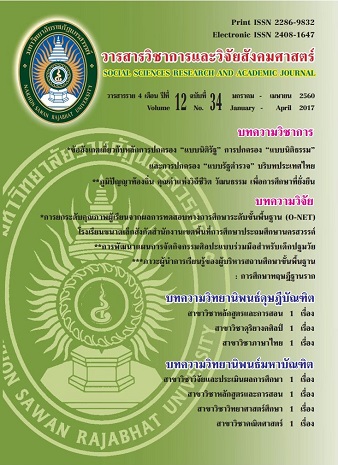การพัฒนาแผนการจัดกิจกรรมศิลปะแบบร่วมมือสำหรับเด็กปฐมวัย; The Development of Participatory Art Activity for Early Childhood Children
Main Article Content
Abstract
บทคัดย่อ
การวิจัยครั้งนี้มีวัตถุประสงค์ดังนี้ 1) เพื่อพัฒนาแผนการจัดกิจกรรมศิลปะแบบร่วมมือสำหรับเด็กปฐมวัย 2) เพื่อประเมินประสิทธิผลของแผนการจัดกิจกรรมศิลปะแบบร่วมมือสำหรับเด็กปฐมวัย กลุ่มตัวอย่าง
ในการวิจัยครั้งนี้ ได้แก่ ครูปฐมวัยที่สอนระดับชั้นอนุบาล ในภาคเรียนที่ 1 ปีการศึกษา 2559 โรงเรียนในสังกัดสำนักงานเขตพื้นที่การศึกษาประถมศึกษานครสวรรค์ เขต 1 เครื่องมือที่ใช้ในการวิจัย ได้แก่ แบบสัมภาษณ์
แบบมีโครงสร้างมีลักษณะเป็นแบบสอบถามปลายเปิด แบบสอบถามความสำคัญของกิจกรรมศิลปะแบบร่วมมือ และแบบประเมินประสิทธิผลของแผนการจัดกิจกรรมศิลปะแบบร่วมมือสำหรับเด็กปฐมวัย ซึ่งมีลักษณะเป็นการประมาณค่า 5 ระดับ ซึ่งเครื่องมือการวิจัยได้ผ่านการตรวจสอบโดยผู้เชี่ยวชาญพบว่ามีค่าความตรง (IOC)
อยู่ระหว่าง 0.67-1.00 การวิเคราะห์ข้อมูลโดยการหาค่าเฉลี่ยค่าเบี่ยงเบนมาตรฐาน และการวิเคราะห์เนื้อหา
ผลการวิจัยพบว่า
1. แผนการจัดกิจกรรมศิลปะแบบร่วมมือสำหรับเด็กปฐมวัยที่เหมาะสมและสอดคล้องกับความต้องการของครู มีจุดเน้นที่สำคัญมากที่สุด ได้แก่ กิจกรรมศิลปะกับการส่งเสริมพัฒนาการเด็กปฐมวัยซึ่งมีความสำคัญ
อยู่ในระดับมากที่สุด (= 4.53) รองลงมา ได้แก่ กระบวนการจัดกิจกรรมศิลปะแบบร่วมมือ (=4.20) กิจกรรมศิลปะสำหรับเด็กปฐมวัย (= 4.16) และผลงานหรือชิ้นงาน (= 4.05) ตามลำดับ
2. ผลการประเมินประสิทธิผลของแผนการจัดกิจกรรมศิลปะแบบร่วมมือสำหรับเด็กปฐมวัย พบว่าแผนการจัดกิจกรรมศิลปะแบบร่วมมือสำหรับเด็กปฐมวัย สามารถส่งเสริมพัฒนาการ 4 ด้านของเด็กในภาพรวมอยู่ที่ระดับมาก (= 4.24) เมื่อพิจารณาเป็นรายด้านแล้วพบว่า ด้านอารมณ์และจิตใจมีระดับดับการพัฒนาสูงสุดอยู่ในระดับมากที่สุด (= 4.62) รองลงมา คือด้านสังคมและด้านสติปัญญา (= 4.33 และ= 4.18) ตามลำดับ สำหรับด้านร่างกายมีผลการประเมินในระดับปานกลาง (= 3.80)
Abstract
The research aimed to 1) to develop the plan of the participatory art activity for early childhood children, and 2) to evaluate the achievement of the participatory art activity for early childhood children. The sample group consisted of preschool teachers in the schools under Nakhon Sawan Primary Educational Service Area Office 1, in the first semester of the academic year 2016. The tools were the structural interview and the 5-scale-levels questionnaire for the development and the evaluation of the participatory art activity for early childhood children. The data analysis included mean, S.D., and content analysis. According to the research, the findings are as follows:
1. The participatory art activity for early childhood children which is appropriate and consistent with the needs of the teacher highly emphasizes on art activity and children development promotion at the highest level (= 4.53). Next are process participatory art activity (=4.20), an art activity for early childhood children (=4.16), and pieces of work (=4.05), respectively.
2. Regarding the achievement of the participatory art activity for early childhood children, it was found that the planning is able to encourage the 4 developments of children in overall at the high level (=4.24). In regards to each aspect, the emotion and the mind have been developed at the highest level (=4.62). Secondly, the social and the intellectual aspect are at the high level (=4.33 and =4.18, respectively). In terms of the least development skill, the physical aspect is at the medium level (=3.80).

